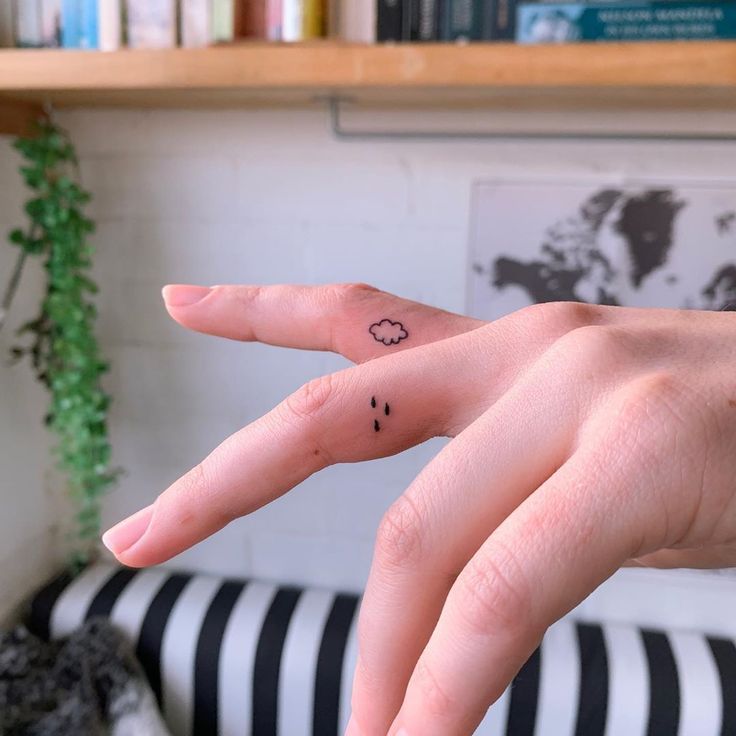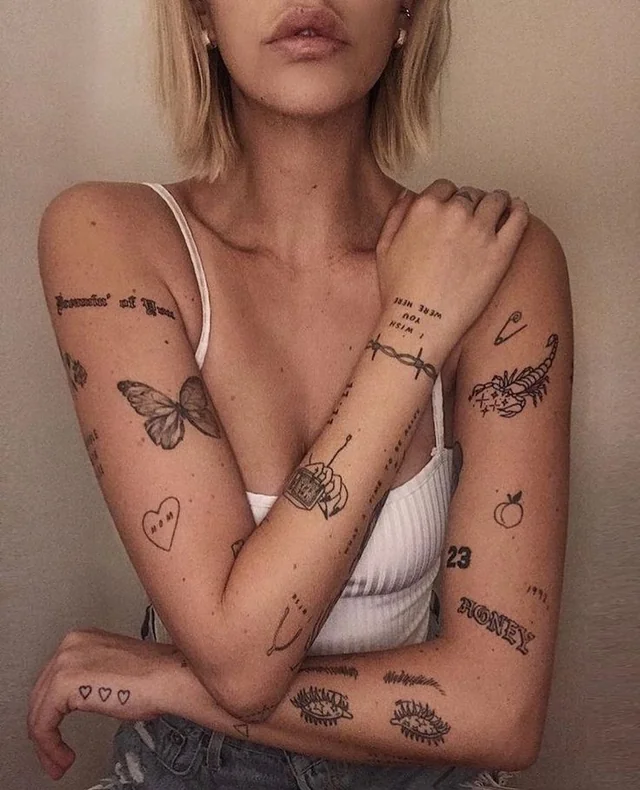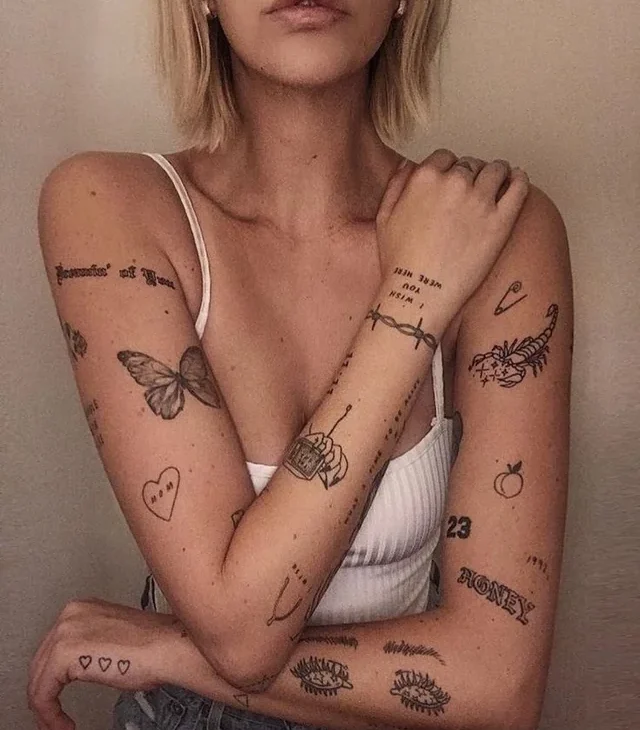Millennial tattoo ideas have substantially altered the map of body art. About 40% of millennials now wear their stories on their skin. The number of Americans with at least one tattoo grew from 21% to 30% between 2012 and 2019. This shows how tattoos have become a mainstream form of self-expression.
Nostalgic themes and personal symbolism show up often in popular millennial tattoos. Many tattoo shops that offer custom tattoos now feature watercolor designs with blended color splotches. Dreamcatcher tattoos are common among millennials, especially when you have them on the hip. Harry Potter tattoos make their mark too, with the Deathly Hallows symbol standing out as a defining millennial trend. A 2023 Pew Research study reveals that 80% of Americans think society accepts people with tattoos more readily now. This acceptance helps explain why millennials welcome this form of self-expression more openly than earlier generations did.

What Makes a Tattoo ‘Millennial’?
Millennials (born 1981-1996) accept tattoos as a form of self-expression more than any previous generation. The numbers paint a clear picture of their relationship with body art that is different from their predecessors.
The rise of tattoos among millennials
Millennials are the most tattooed generation in history. Nearly half (47%) of millennials have at least one tattoo, with an impressive 29% sporting multiple pieces of body art. A 2021 study showed that 12% of millennials had one tattoo, while 29% had multiple.
This growing popularity of tattoos shows a fundamental change in this generation’s view of permanent body art. Their parents often saw tattoos as rebellion or part of fringe subcultures. Millennials see them as personal markers of identity and growth. Tattoo culture has changed from being stigmatized to becoming an accepted art form.
The workplace has adapted to this cultural change. A 2023 survey showed that two-thirds of employees believe their tattoos fit well in professional settings. On top of that, a striking 91% of employees believe visible tattoos do not affect their colleagues’ professionalism. Millennial leaders continue to reshape workplace norms with their accepting views.
How millennial ink differs from other generations
Millennial tattoo priorities stand out from earlier generations. Gen X might have faded tribal designs from the ’90s, but millennials prefer:
- Neo-traditional and new school designs with intricate details and vibrant colors
- Watercolor tattoos with soft, painterly effects lacking harsh outlines
- Nostalgic imagery from childhood cartoons, Disney, and Harry Potter
- Fine-line work that looks like delicate pencil sketches
- Minimalist designs with clean, simple lines that tell powerful stories
Unlike previous generations who hid their tattoos, millennials choose more visible spots. Tattoo professionals note that millennials often pick “the lower back, hip bone, shoulder blade, top of the foot, rib cage, forearm, inner wrist”. This shows their comfort with displaying body art publicly.
Millennial’s tattoo choices carry deeper meaning. The ’90s tribal armband might have been purely decorative, but millennials choose designs that tell their stories or mark life events. They view tattoos as “deeply personal markers of identity and growth” rather than just decoration.
Why tattoo artists notice generational patterns
Tattoo artists spot generational patterns because they see how design priorities cluster among age groups. An artist from Axiom Tattoo in San Diego noted that “millennials used to get Harry Potter tattoos, specifically the Deathly Hallows symbol,” and many “are now getting cover-ups of those tattoos”.
Social media has changed how millennials pick their tattoos. “Having access to the tattoos of thousands of artists at their fingertips has raised the quality of a ‘good tattoo idea'”. Global tattoo art exposure has lifted standards and expectations.
Artists see clear differences in how generations approach getting tattooed. Millennials come to shops with more research and higher expectations than previous generations. They still follow recognizable trends that artists easily spot. One artist mentioned seeing “infinity symbols and little lotus flowers” as typical millennial choices.
Innovative tattoo technology has shaped millennial tattoo priorities. Modern machines offer precise detail work, allowing for realistic portraits and delicate single-needle designs. These technical improvements have made tattoos more available and customizable. Millennials now feel confident adding body art to their personal story.
Popular Millennial Tattoo Ideas You’ve Definitely Seen
Step into any tattoo shop offering custom work and you’ll notice clear patterns among millennial clients. These artists can spot this generation’s distinct style right away. Let’s look at the most popular millennial tattoo ideas that have shaped the industry.
Infinity symbols and lotus flowers
Millennials love infinity symbols, which rank among their top design choices to represent eternal love or endless possibilities. These simple yet meaningful symbols peaked between 2010-2015, when many clients added names, dates, or hearts to personalize them. Lotus flowers strike a chord with this generation’s search for meaning and personal growth. These designs have become so widespread that tattoo artists now playfully call them “millennial classics.”
Watercolor and pastel designs
Watercolor designs stand out as one of the most unique millennial tattoo trends. These pieces look like watercolor paintings with bright color splashes that seem to flow past black outlines, creating an artistic effect. This style took off around 2012 and remains popular today. Millennials also lean toward pastel colors when they want softer, more subtle artwork compared to Gen X’s bold traditional styles.
Harry Potter and nostalgic cartoon tattoos
Nostalgia shapes many millennial ink choices. Tattoo artists quickly recognize Harry Potter designs, with the Deathly Hallows symbol leading the pack. Millennials also love getting:
- Disney characters from their childhood
- ’90s cartoon icons like Pokémon or Rugrats
- Video game imagery from their early gaming days
These nostalgic picks serve as lasting tributes to cultural icons that helped shape millennial identities.
Minimalist and fine-line tattoos
Minimalist designs mark a clear shift from previous generations’ bold, heavy tattoos. Fine-line work looks like delicate pencil sketches and has become a millennial favorite. These subtle designs often showcase geometric shapes, tiny symbols, or single-word mantras. Their appeal comes from looking elegant yet versatile – easy to hide at work but show off in casual settings. Many top artists in Flint, MI say these simple designs with minimal lines and negative space fill most of their daily schedules.
Ribcage and forearm placements
Tattoo placement tells us a lot about generational differences. While older generations picked upper arms or backs, millennials choose more visible spots. Forearm tattoos start conversations instead of staying hidden. Millennial women often pick the ribcage for personal designs. The inner wrist, behind the ear, and along the collarbone are also popular spots that can be shown or covered as needed.
Millennial tattoo choices reflect their values, experiences, and style. From watercolor designs to Harry Potter symbols, these generation-defining picks show how millennials express themselves through body art.

The Hidden Influences Behind These Trends
A complex mix of cultural and tech influences shapes how millennials choose their tattoos. These subtle yet powerful forces create distinct patterns you’ll see in tattoo shops nationwide.
Social media and celebrity inspiration
Instagram has changed everything about how tattoo culture grows and spreads. Millions of #tattoo posts are just a thumb scroll away, giving millennials what feels like the world’s biggest tattoo convention right in their pockets. People now expect higher quality work because they can see amazing tattoo art from around the globe.
Celebrities play a vital role in making tattoos mainstream among millennials. Justin Bieber’s neck tattoo or Rihanna’s latest ink turns tattoos from rebel statements into fashion choices. Artists who ink celebrities like Rihanna and Selena Gomez have become famous themselves. Bang Bang and other popular artists have built massive followings that turn their work into must-see social content.
Pinterest boards and TikTok trends
Each social platform has its own tattoo trends as millennials share their body art dreams. Pinterest has become the go-to place to find tattoo inspiration. Users browse thousands of designs in categories like “Y2K Tattoo Ideas” and “Small Baddie Tats”. They can save ideas through hashtags before heading to their local shop.
TikTok shapes millennial tattoo culture in powerful ways, making certain designs go viral overnight. The Medusa tattoo spread quickly as a symbol of sexual assault awareness after a TikTok user designed and shared it. Videos showing tattoo transformations and placements get millions of views and create immediate trends.
The role of identity and self-expression
Millennials see tattoos as more than just pretty designs. They want something permanent in a world where digital content vanishes – Instagram stories last 24 hours and Snapchats disappear in seconds. Tattoos give them stability in what sociologists call an increasingly “fragmented and chaotic” world.
These permanent marks help millennials shape their identity rather than just show it. Professor Anne Velliquette, who studies consumer behavior, explains that tattoos become part of millennials’ “personal myths” that connect their “remembered past, perceived present, and anticipated future”. This explains why about 40% of millennials have at least one tattoo.
Millennial tattoo choices show a generation looking for something lasting in a digital world built for constant change. Their tattoos aren’t just trendy designs but “deeply personal markers of identity and growth” that stay constant while everything else shifts.
What Tattoo Artists Won’t Tell You (But Should)
Tattoo artists know things they don’t tell their millennial clients right away. This knowledge could help everyone avoid disappointment later.
Why some designs age poorly
Time isn’t kind to many popular millennial tattoo styles. Watercolor tattoos look great on Instagram but blur substantially after 5-10 years because they lack strong black outlines to contain the design. Fine-line tattoos, another millennial favorite, expand and fade faster than bold traditional designs. Small text becomes unreadable as ink spreads under the skin and turns clear words into blurry shapes. White ink tattoos might seem subtle at first, but they either vanish or develop an odd yellow tinge within months.
Cover-up trends and regrets
Tattoo shops see more millennial clients who want to cover their old ink. Infinity symbols, dream catchers, and arrow tattoos top the list of designs people want gone. About 78% of artists say they get more requests to cover trend-based tattoos from 2010-2015. Most first-timers pick designs based on what’s popular instead of what matters to them. These simple trend-based tattoos now transform into custom pieces with lasting appeal.
The truth about placement and fading
Your tattoo’s location is a vital factor in how long it lasts, but artists rarely mention this during consultations. Finger tattoos might trend on social media, but they need touch-ups every 6-12 months from daily wear and tear. Sun exposure makes tattoos fade faster – forearm pieces show substantial wear within 5 years without proper protection. Expert artists in Flint, MI confirm that tattoos on joints blur quicker because the skin moves and regenerates constantly.
How artists feel about ‘basic’ tattoos
Professional artists maintain their composure but secretly tire of requests for common designs. Research shows 65% of artists feel creatively stifled by trending designs. Artists respect their clients’ choices but prefer creating original pieces that showcase their talent. Each generation has its tattoo markers – Gen X chose tribal designs, while millennials pick predictable patterns that artists spot right away. Quality artists put their clients’ satisfaction ahead of their own artistic priorities.
How to Choose a Tattoo That Lasts Beyond the Trend
Body art needs careful thought beyond what’s trending on Instagram. Creating lasting millennial tattoo ideas needs a balance between personal meaning and timeless design principles.
Think about long-term meaning
A design with personal significance helps you stay happy with your tattoo for decades instead of months. Celebrity tattoo artist Dillon Forte emphasizes: “People should love their tattoos for years or decades since it’s permanent as opposed to days, weeks, or months.” Tattoos that tell your personal stories, celebrate milestones, or reflect your deeply held values stay relevant whatever trends come and go. The most meaningful millennial tattoos often connect to:
- Your cultural heritage and family story
- Life achievements and important moments
- Core values that shape who you are
Avoiding overdone designs
Expert tattoo artists suggest staying away from celebrity-inspired designs that quickly become dated. Hepcat, a seasoned tattoo artist, points out that infinity symbols, dream catchers, and certain lion tattoos are now overdone. Classic designs like eagles, hearts, and roses stand strong against time because of their deep roots in tattoo culture. Your design choice should reflect your personal story rather than following current trends.
Tips for customizing common ideas
Common tattoo ideas can become uniquely yours with smart customization. Before you commit, look at:
- Your chosen spot affects design options—bigger, detailed pieces fit better on thighs, back, or arms, while subtle designs work well on wrists or collarbones
- Slightly bigger tattoos with bold, clean lines age better than complex designs with thin lines
- You can make common symbols your own by adding elements from your life story
Working with your artist for originality
A good partnership with your tattoo artist creates the best results. During this process:
- Share your vision clearly but listen to professional advice about what works best on skin
- Show reference images to explain your style, but don’t ask artists to copy someone else’s work
- Speak up when artistic choices aren’t clear—skin behaves differently than paper, and technical decisions affect how your tattoo lasts
Note that it’s better to “Express your personality and your passions” than follow passing trends.
Summing all up
Tattoos mean much more than body art to millennials. These permanent marks tell stories of personal trips, memories, and identity in ways older generations never did. A careful thought process before getting inked remains vital to avoid future regrets.
Millennial priorities have altered the map of tattoo culture. Body art has evolved from rebellion to a mainstream form of self-expression. Popular millennial designs face real challenges as time passes. Watercolor tattoos lose their edge, thin lines expand, and trending symbols often need cover-ups later.
Social media has sped up tattoo trends, which creates both chances and risks for people wanting permanent art. Quick decisions based on TikTok trends might not match well with tattoos that last forever. The best approach combines deep personal meaning with classic design elements.
Tattoo artists love clients who choose original designs over trending ones. Most artists won’t say it out loud, but they’d rather create custom pieces than repeat infinity symbols or dreamcatchers. The best results come when client ideas merge with an artist’s expertise.
Millennials now face a choice between true self-expression and fleeting trends. Smart choices mix personal meaning with proven tattoo methods that last. Great tattoos should tell your story whatever the current fashion. They become part of who you are instead of just following what everyone else does.
Here are some FAQs about millennial tattoo ideas:
What tattoos do millennials get?
Millennials often choose meaningful and personalized designs, with popular millennial tattoos including minimalist symbols, delicate line work, and nature-inspired motifs. Many opt for simple millennial tattoos like tiny hearts, constellations, or subtle script that hold personal significance. Studios like Millennial Ink- Tattoo Shop-Custom Tattoos-Top Tattoo Artist Flint, MI specialize in creating these custom pieces that reflect individual stories and aesthetics.
Why are so many millennials getting tattoos?
Millennials view tattoos as a form of self-expression and a way to commemorate important life moments, leading to the rise in millennial tattoo ideas. Unlike previous generations, they see body art as socially acceptable and even empowering in professional and personal settings. The accessibility of skilled artists, such as those at Millennial Ink- Tattoo Shop-Custom Tattoos-Top Tattoo Artist, has also made getting inked more appealing.
What percent of millennials have a tattoo?
Studies show that around 40% of millennials have at least one tattoo, making them one of the most tattooed generations. Many of these individuals have multiple pieces, ranging from popular millennial tattoos to larger custom designs. The trend reflects their openness to body art as a mainstream form of creativity and identity.
What is the Gen Z tattoo style called?
Gen Z’s tattoo aesthetic is often referred to as “ignorant style,” featuring bold, abstract, and sometimes cartoonish designs. Unlike the simple millennial tattoos, this style embraces rough lines and unconventional imagery, prioritizing self-expression over perfection. Both generations frequent shops like Millennial Ink- Tattoo Shop-Custom Tattoos-Top Tattoo Artist Flint, MI, but their preferences differ significantly.
Why are Gen Z regretting tattoos?
Gen Z’s impulsive approach to tattoos, often choosing trendy or meme-inspired designs, leads to higher regret rates compared to millennials. Many later find these pieces don’t align with their evolving tastes, unlike the more timeless popular millennial tattoos. The permanence of ink becomes a lesson in careful consideration for younger generations.
What time period are millennials?
Millennials, also known as Generation Y, were born between 1981 and 1996, making them currently in their late 20s to early 40s. This generation grew up during the rise of the internet, shaping their preferences for everything from technology to tattoos. Their influence is evident in trends like simple millennial tattoos and the demand for custom work from shops like Millennial Ink- Tattoo Shop.
Are tattoos losing popularity?
Tattoos are not losing popularity but evolving, with millennials and Gen Z continuing to drive demand for ink in different styles. While popular millennial tattoos lean toward meaningful minimalism, younger generations experiment with bolder designs. Studios like Millennial Ink- Tattoo Shop-Custom Tattoos-Top Tattoo Artist Flint, MI adapt to these shifts, ensuring tattoos remain a thriving art form.














